(Ti/Zr,N) codoped hematite for enhancing the photoelectrochemical activity of water splitting†
Abstract
In this theoretical study, first-principles calculations were carried out to explore the photocatalytic activity of cation (Ti or Zr) and anion (N) compensated codoped hematite based on density functional theory (DFT). For (Ti/Zr,N) codoped hematite, the band edges of the conduction band and the valence band move close to each other, leading to an obvious bandgap reduction. Compared with the pure hematite, the optical absorption coefficient of codoped hematite is significantly enhanced in the visible light region. The charge distribution at the conduction band minimum (CBM) and valence band maximum (VBM) is spatially separated after codoping, which is beneficial for extending the carrier lifetime. More interestingly, the CBM becomes electronically delocalized in (Ti,N) doped hematite, which indicates better carrier transport properties in the bulk system. Due to these special features of (Ti/Zr,N) codoped hematite, an improved photocatalytic performance can be expected.


 Please wait while we load your content...
Please wait while we load your content...